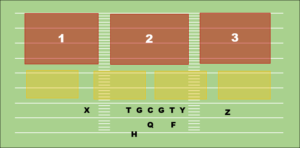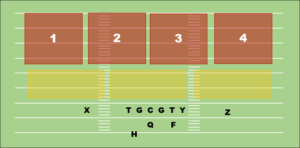What kind of defense is the WFT going to run?
August 17, 2020
By Noonefromtampa
Last week’s column looked at the offense and terminology used in Scott Turner’s Air Coryell scheme (click here to read). This week’s column will look at what type of defense the Washington Football Team will scheme in 2020.
Everyone knows that the team converted from a 3-4 defense to a 4-3 defense, but what does that mean? I will cover a basic overview of how a 4-3 defense can be run and how the current coaches have used it in the past.
The main figures in deciding what type of defenses are going to be used are head coach Ron Rivera, defensive coordinator Jack Del Rio, and defensive backs coach Chris Harris.
Defensive Fronts
A 4-3 defense is generally a one-gap scheme where each defender in the 7-man front has responsibility to defend one gap, denoted by a letter, versus a running play. There are hybrid fronts used in a 4-3 that use 8-man fronts or two-gap techniques. This is done to counter specific offensive formations or disguise what the defensive scheme actually is. There are two common fronts used in a 4-3, an over front and an under front.
In an over front, the defensive line shifts toward strong side of the offensive formation, which is the side of the tight end. An under front shifts toward the weak side of the offensive formation, away from the tight end. In both fronts, the lineman and linebackers have specific techniques and position alignments they play. The techniques are numbered 0 through 9, with 0 starting at center and 9 being on the outside. Visually this looks like:

You’ll frequently hear this when analysts talk about prospective player before the draft where a defensive tackle may only be able to play a 3-technique role in a defense. The 3-technique is where one defensive tackle is lined up to the outside shoulder of the guard to the strong side (over) or weak side (under), while other defensive tackle plays a 0 (over) or 1 (under) technique.
In the over front, the strong side linebacker (called Sam) aligns to the outside of the tight end which makes the front 7 look like a 3-4 front with one of the ends playing with their hands in the dirt. This is why analysts say the difference between 4-3 and 3-4 fronts is not that great.
The other half of the defense is the type of coverage run in the defensive backfield. Looking at the defenses that Rivera and Del Rio have run in the past, they both favor basic coverage schemes and rely on the four defensive linemen for pass rushing, rarely blitzing. Where things differ is that Rivera, Del Rio and Harris all have focused on different coverage schemes in the last several years. Rivera’s Panthers team played a lot of zone coverages, especially Cover 4, while Del Rio’s past teams have favored a cover one, man coverage scheme and Harris used a Cover 3 scheme in San Diego, with much success.
Coverage Schemes
Cover 1 is a single high safety look with the cornerbacks playing man coverage against the wide receivers and the strong safety or Sam linebacker covering the tight end. It’s a simple scheme that requires good cover cornerbacks to blanket the wide receivers. The offensive call to beat a cover 1 defense is either the mesh play (diagram here) or four vertical routes, overloading one side of the field with 3 receivers.
The defense can counter the mesh play with a plug coverage where one of the linebackers or strong safety take a zone position in the middle of the field to take away the underneath crossers.
Cover 3 is a zone coverage shell where 3 defensive backs divide the deep portion of the field into thirds with some form of underneath zone. This is a cover 3 scheme look:

In cover 3, the normal coverage is for the cornerbacks to take deep zones on the outside thirds of the field while the free safety takes the middle third. Underneath coverage is typically a zone using some combination of linebackers, strong safety and/or nickel/dime defensive backs. This is a very versatile coverage scheme that allows the strong safety to crash down on run plays while taking away middle field crossing routes underneath. The underneath coverage can also be a man coverage scheme.
Cover 4 (also called quarters) is a zone coverage shell with 4 deep defenders. The cornerbacks cover the outside deep zones, while the safeties handle the deep middle zones. Like in Cover 3, the underneath coverage is typically a zone but also can be man coverage. This is a cover 4 scheme look:

Like Cover 3, the underneath coverage in Cover 4 is played by using some combination of linebackers, strong safety and/or nickel/dime defensive backs. This coverage is designed to counter vertical passing attacks, but only leaves 7 defenders to counter runs and short passes.
What the WFT Defense May Look Like
With no preseason games it is not clear what the new defense of the team is going to look like. This will be one advantage going into the first game against the Eagles.
For me, the biggest tells so far this season have been drafting Chase Young and the fact that Reuben Foster came off the PUP list. When Foster was with the 49ers he excelled in the 4-3 under, Cover 3 defense that team was running at that time. The big question is whether Foster will have the same closing speed after his knee injury that made him so good in that style defense. Also, if Foster can’t perform in the middle, will Jon Bostic be able to handle the job? The one thing I’m fairly certain of at this point is that Thomas Davis, Sr. won’t be on the field on obvious passing downs.
The Young pick means that the defense will most likely stay with 4-man rush packages with the occasional blitz thrown in. One prediction I will make is that Del Rio will use the speed of Cole Holcomb in blitz packages.
In summary, I think the main coverage schemes will be Cover 3 and man Cover 1 against teams that prefer the short passing game. They will utilize the Cover 4 scheme against teams that go more vertical in their passing attacks.
